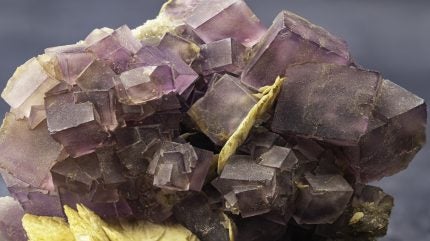
Elementos, an exploration and development company, has discovered a zone of fluorite mineralisation at the Foleys Zone Exploration Target beneath the Cleveland Tin Mine in north-west Tasmania.
This find, which includes a single continuous zone of 319.5m at 5.97% fluorite (CaF2), is in addition to previously reported assays of critical minerals such as tungsten, rubidium, molybdenum and bismuth.
The latest assays from the Cleveland Project in Tasmania reveal a 394m stretch of high-grade fluorite mineralisation within the Foleys Zone. The company is now planning a comprehensive review of historic data and a geophysical programme to identify further targets.
Elementos managing director Joe David said: “The Cleveland Tin Project has officially emerged as more than just a tin and copper project, its critical minerals potential has exceeded all expectations and could amplify possible future economic outcomes for the development considerably.
“Multiple assays have confirmed significant and continuous mineralisation over 500m made up of fluorite, tungsten, rubidium, molybdenum and bismuth.”
“Desktop programmes are now under way, which may also lead to the re-logging and sampling of historic core, will seek to quantify grades and tonnages of these critical minerals that are likely to be co-mineralised but previously unreported within the current 4.0mt tungsten inferred mineral resources estimate (MRE).”
Access the most comprehensive Company Profiles on the market, powered by GlobalData. Save hours of research. Gain competitive edge.

Your download email will arrive shortly
We are confident about the unique quality of our Company Profiles. However, we want you to make the most beneficial decision for your business, so we offer a free sample that you can download by submitting the below form
By GlobalData
“The company remains focused on developing the 7.5mt of tin and copper mineral resources associated with the old tin mine, with both these minerals listed as critical and/or strategic minerals in Australia and the USA,” David added.
The fluorite discovery was made following the completion of drill-hole C2124/C2124A, which reached a depth of 1,122m.
The assays from this drill hole, which had to be analysed in Canada due to their complexity, confirm the presence of a large, high-grade fluorite zone. The Foleys Zone is now recognised as an important source of multiple critical minerals.
Elementos is set to use the recovered drill core to refine its understanding of the mineralisation, which may lead to re-evaluation of previously unmineralised zones.
The company is also considering the application of XRT ore sorting technology to enhance mineralisation grades.
Historical exploration had suggested a link between the Foleys Zone tungsten mineralisation and a quartz porphyry dyke.
Although the drill hole deviated from its intended target, the intersection of numerous mineralised quartz veins near the dyke has provided valuable insights into the mineralising system’s scale and potential.



